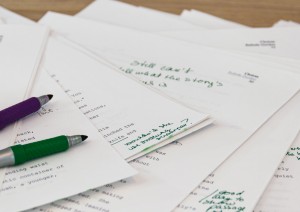Life Lesson: Practice What You Teach
 As 2015 came to a close and winter break was upon us, I had some time to reflect upon my teaching practice, as I planned for my next units of study. I remembered how, at the beginning of the year, we received from our Literacy Specialist an immersion packet. The packet suggested several teacher-written pieces, which would go along with the units from Atlas.
As 2015 came to a close and winter break was upon us, I had some time to reflect upon my teaching practice, as I planned for my next units of study. I remembered how, at the beginning of the year, we received from our Literacy Specialist an immersion packet. The packet suggested several teacher-written pieces, which would go along with the units from Atlas.
The assignment was overwhelming to say the least. Several colleagues remarked that there was no way they were going to do that much writing, on top of everything else that had to be done.
But once we dug into the units with our students, we remembered quickly the importance of writing for—and with—our learners.
When students see me engaging in the writing I am asking them to do, they immediately view it as authentic. I always choose my stories carefully to avoid students’ copying my subject matter (a lesson learned in previous years). And I never do just one draft and call it good.
I have found that if I allow them to see my struggles and imperfections, they are more open to our revising and editing sessions with their work. I will intentionally write stories that I know need revision, allowing my students to see that even adult writing needs work. I write for them and use my pieces to write with them. We even do shared pieces based on shared experiences. Once, for instance, we brought a microwave into the classroom and popped popcorn so that we could all write a descriptive paragraph together. That was a lesson they never forgot!
The Conversation with Editing
Probably the best lesson for me with editing and revision has come through the writing of this blog. After I submit my pieces, our editor does his thing, which means inevitable changes to sentence structure, word choice, and sometimes even titles. I have to admit, it can be hard to take at times. This made me realize that I need to be more gentle in my approach with my students; more conversation needs to happen as I go through their pieces. It also made me realize how shared writing, revising and editing can help my students achieve better results.
After I submit my pieces, our editor does his thing, which means inevitable changes to sentence structure, word choice, and sometimes even titles. I have to admit, it can be hard to take at times. This made me realize that I need to be more gentle in my approach with my students; more conversation needs to happen as I go through their pieces. It also made me realize how shared writing, revising and editing can help my students achieve better results.
So as I sat in my very quiet classroom planning our launch for our next unit, I decided I would try writing the assignments that I give students, lesson by lesson. I’ll find what fits, what doesn’t, and what I need to move around. I’ll analyze my points of frustration and do my best to anticipate what will be stumbling points for my students. Will it be perfect? No, of course not. But I’m sure I’ll learn a few things along the way that will make it better than if I taught it without trying it.
When it comes to writing, I’m not sure that practice ever makes perfect. But it certainly makes me a better teacher.
 Beth Rogers is a fifth grade teacher for Clarkston Community Schools, where she has been teaching full time since 2006. She is blessed to teach Language Arts and Social Studies for her class and her teaching partner’s class, while her partner teaches all of their math and science. This enables them to focus on their passions and do the best they can for kids. Beth was chosen as Teacher of the Year for 2013-2014 in her district. She earned a B.S. in Education at Kent State University and a Master’s in Educational Technology at Michigan State University.
Beth Rogers is a fifth grade teacher for Clarkston Community Schools, where she has been teaching full time since 2006. She is blessed to teach Language Arts and Social Studies for her class and her teaching partner’s class, while her partner teaches all of their math and science. This enables them to focus on their passions and do the best they can for kids. Beth was chosen as Teacher of the Year for 2013-2014 in her district. She earned a B.S. in Education at Kent State University and a Master’s in Educational Technology at Michigan State University.
